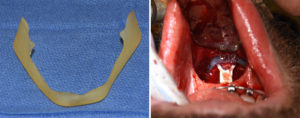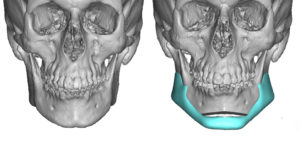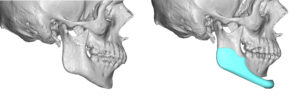Background: Custom jawline implants are usually the best surgical method for changing the 3D shape of the lower face. Through a computer-designing process an implant can be designed to cover jaw angle to jaw angle crossing the chin in the middle. Covering such a large bony surface area, even when the dimensions of the implant seem fairly small, can have a more powerful effect on jaw augmentation than the numbers alone would lead one to think.
A custom jawline implant works, like all implants anywhere on the body, by pushing out the overlying soft tissue to create its aesthetic effects. But the ability of the soft tissues to expand is not the same across the jawline. The jaw angle tissues are softer and more expandable than that of the chin. As the chin is a projecting bony structure the soft tissues over it are tighter and more attached than any other tissues along the jawline.
The tightness of the soft tissues over the bony chin pose some considerations when larger chin augmentations are desired, particularly when an implant is being used to do it. How well will the soft tissues be pushed out, what happens to the depth of the labiomental fold and what are the long-term implieations of having a large implant load in the chin? For these reasons some patients may feel more comfortable with bony sliding genioplasty for their chin augmentation rather than using an implants. But can a sliding geniplasty be combined with an implant to augment the jawline behind it?
Case Study: This young male wanted to augment his entire jawline. By computer imaging it was determined that the chin part of the augmentation needed to come forward around 12mms and he was more comfortable with moving the chin bone rather than doing it with an implant.


A custom jawline implant can be combined with a sliding genioplasty in a synergistic manner to create a total jawline augmentation effect. This auto-alloplastic approach to jawline augmentation can only be effectively done with a 3D computer designing process.
Highlights:
1) Large amounts of chin augmentation with an implant may exceed the tolerance of the soft tissue chin pad.
2) A sliding genioplasty is often better long-term for the soft tissue chin pad in larger advancements but it does cause side or lateral wing aesthetic deformities and will make the chin appear less wide.
3) Custom jawline implants can be combined with a sliding genioplasty to create a wider chin and a smoother jawline back to augmented jaw angles.
Dr. Barry Eppley
Indianapolis, Indiana




